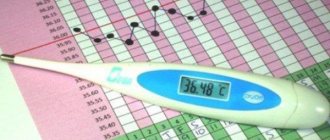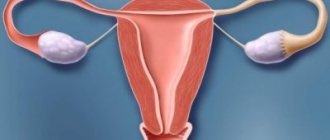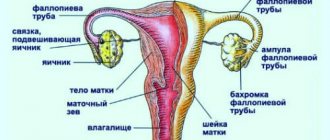It is not for nothing that gynecologists closely monitor the condition of the cervix - changes in this organ signal not only pregnancy, ovulation and the approach of menstruation, but also many infectious diseases and pathological abnormalities.
Typically, the condition of the cervix is affected by endometriosis, cancer and other malignant tumors. Therefore, it is recommended to check the organ before menstruation and during ovulation.
It is considered normal if the cervix before menstruation is hard to the touch and dry. During ovulation, on the contrary, it opens and becomes loose, preparing for fertilization. If pregnancy does not occur, then there will be critical days. The position of the cervix before menstruation is low. A completely different picture during ovulation and conception - the organ softens, becomes moist, and the pharynx opens slightly (pupil symptom). So the cervix before menstruation and during pregnancy are two different things. It is by these signs that a gynecologist can determine conception in the early stages. In addition, the fertilized uterus acquires a bluish tint, since during this period the number of vessels in the organ increases.
Also, many women are interested not only in what it feels like, but also in what the cervix looks like before menstruation. Of course, it is impossible to look into the vagina on your own and examine the organ, but you can determine its type by palpation - the uterus descends and can be easily palpated, and the pharynx contracts tightly. That is, if during ovulation the cervix looks like a tubercle with a dilated “pupil,” then before the critical days the “eye” of the organ is much smaller.
Cervix during menstruation
We found out what the condition of the cervix is before menstruation, now we will find out what it looks like directly on menstruation days. At this time, the pharynx expands slightly, as during ovulation, but the purpose of this opening is different - not readiness for fertilization, but the desire to erupt blood clots. This position of the cervix during menstruation creates fertile ground for the proliferation of bacteria and the addition of infection. That is why on critical days it is not recommended to swim in open water, visit the pool, have unprotected sex and insert foreign objects into the vagina - fingers, a speculum. Although the moderate mucous discharge that is observed during this period is designed to protect the woman from infection, it is still not worth the risk.
The condition of the cervix during menstruation requires external hygiene
.
Ideally, you should wash yourself twice a day, not counting the procedures after bowel movements. You cannot wipe the anus in a forward direction - such actions are fraught with infection. It is also strongly recommended not to carry out water procedures inside the vagina during this period - no douching or insertion of intimate hygiene products. Often during menstruation, women experience pain in the uterus.
Most often they are associated with the rejection of blood clots. In this case, conventional antispasmodics help. But sometimes painful contractions of the cervix signal an infection or pathology in the development of the organ. Therefore, do not neglect routine examinations with a gynecologist, so as not to lead to infertility from a common illness.
By the way, it is not so much pain, which is often a sign of dysmenorrhea, as heavy discharge that warns of abnormalities - fibroids, endometriosis, bleeding disorders and acute infections. In any case, after your period, especially if the pain in the uterus has not stopped, you should consult a doctor and do an ultrasound. If the cause of discomfort is dysmenorrhea, then it makes sense, along with painkillers or contraceptives, to take a course of vitamins and Omega-3 complex. If the cause of the pain is a serious illness, you should immediately begin treatment prescribed by the gynecologist.
After menstruation
A healthy cervix after menstruation begins to prepare again for conception. Immediately after the end of the critical days, the pharynx narrows, because the bleeding has stopped. Simultaneously with the organ being pulled up, the endometrium begins to grow, into which a fertilized egg can be implanted during conception. In addition to its high location, the conditions of the cervix before and after menstruation are similar - the same dryness and tissue density.
But during the period of ovulation, the organ loosens again and begins to secrete mucus. The norm during this period is contraction of the uterus, but if it is still enlarged, then we can talk about pregnancy, a tumor or an infection.
There is no need to think that conception during menstruation is impossible - despite the reduced fertility of the organ, there is some probability of becoming pregnant. Therefore, if the uterus has not contracted after the critical days, then it is worth getting tested for hCG or having an ultrasound.
It’s another matter if you are not pregnant, but neoplasms are found on the cervix - we can talk about polyps, erosion or fibroids. However, only a gynecologist can determine whether the uterus is enlarged or not. The woman feels unlikely to be able to independently identify suspicious signs.
Naturally, there is a preliminary diagnosis method that is easy to apply at home. This is self-palpation of the cervix. The manipulation must be carried out extremely carefully.
If something is bothering you, it is easier to conduct a preliminary examination at home than to be nervous before going to the gynecologist. It is better to cut the nails on the index and middle fingers of your right hand and put on a sterile glove before starting palpation.
The easiest way to feel the uterus is while sitting on the toilet, squatting or placing one foot on the sofa, the edge of the bathtub, etc. You can try to take a position similar to the one you take in the gynecological chair.
So, insert two fingers into the vagina and feel the tubercle. This is quite easy, the main thing is not to make sudden movements to avoid injury to the organ. But determining the consistency of the cervix is not so easy if you are not a professional. Only the comparison method will help the amateur.
And yet, you can find out something on your own - if the middle finger literally rests on the cervix, it means that it is located quite low, as before menstruation. If you can barely reach it, then the uterus has contracted, as it should after menstruation. Remember, before starting and especially during menstrual periods, it is not recommended to palpate the organ.
What are the risks of self-examination?
If you are used to constantly palpating the cervix, refrain from manipulation at least 2-3 days before menstruation. Even the doctor will prefer to postpone the examination until the end of menstruation and here's why.
Starting from puberty until the onset of menopause, a woman’s body undergoes monthly cyclic changes. A special period is the time before menstruation, when an increase in the size of the uterus can be noticed.
Self-examination and possible consequences
If after menstruation there remains a feeling that the organ is enlarged, this is a reason to be wary. This condition is not normal. In this case, you need to contact a specialist.
You can first perform a self-diagnosis of the uterus, but this process requires great caution. There is a risk of injuring the delicate mucous membrane or causing infection in the reproductive organs. This procedure is strictly prohibited during menstruation; during this period the body is especially vulnerable.
To palpate the cervix yourself, you must perform the following steps:
- cut your fingernails short;
- wash your hands and external genitalia thoroughly;
- put on sterile medical gloves (sold in pharmacies, always individually packaged);
- sit comfortably - either squat down or put one leg higher;
- insert the index and middle fingers into the vagina, trying to feel the cervix.
It is necessary to carry out the procedure slowly, without making sudden movements, otherwise there is a high risk of injuring the mucous membrane. If you can easily feel your cervix and it is soft, it means that menstruation will begin soon. If it is difficult to reach, it is raised and hard to the touch, you can assume pregnancy or ovulation.
Self-diagnosis is not a reliable or reliable way to make sure everything is fine. There is also a high risk of infection or injury. An examination by a qualified gynecologist is a more informative and safe procedure.
If unusual sensations occur, you should not postpone a visit to the doctor. The cause of discomfort can be not only pregnancy, but also a serious illness. Timely diagnosis and treatment reduce the risk of severe consequences for a woman’s reproductive health.
How does the woman feel?
The uterus is a hollow, pear-shaped organ located inside the pelvis. Its size depends on age, history of pregnancy and the phase of the menstrual cycle. Average indicators: 6-8 cm in length and about 5 cm in width.
The size and degree of enlargement can only be determined by a doctor during examination or ultrasound examination. In gynecology, it is customary to measure the condition of the genital organs not in centimeters, but in weeks, by analogy with pregnancy.
However, many women, when describing their condition before or during menstruation, refer to the feeling of an enlarged uterus. This occurs due to a change in the position of the organ and lowering of the cervix closer to the opening of the vagina to improve the outflow of menstrual flow.
Another cause of such sensations may be premenstrual syndrome (PMS), accompanied by the following symptoms:
- nagging pain in the lower abdomen and lower back;
- migraine;
- dyspeptic disorders (nausea, vomiting, diarrhea);
- increased sensitivity of the mammary glands, their engorgement;
- swelling, bloating;
- blood pressure surges;
- psycho-emotional disorders (depression, irritability and others).
Manifestations of PMS disappear with the onset of menstruation or after the end of the discharge. According to statistics, they are rare in girls under 30, and with age the number of people with this problem reaches 50%.
The uterus can be enlarged upon conception: in the early stages it is the same size as a few days before the onset of menstruation. Patients who want to get pregnant are interested in how many days before the start of menstruation they can notice changes in size, so that in the absence of discharge they can be confident in the result.
There is a self-diagnosis technique by inserting the middle and ring finger into the vagina. Before the examination, put on a rubber glove and squat down, placing one leg on a hill. If the middle finger easily reaches a small tubercle - the cervix - the period before menstruation begins.
Unfortunately, this method is ineffective; the time frame is individual and varies from 2 to 14 days. An experienced doctor who notices an increase and decrease in the cervix, shortly before the expected period, will ask you to come in for an appointment in 2 weeks to clarify the diagnosis.
Girl, 25 years old. I consulted a gynecologist with complaints of nagging pain in the lower abdomen, a delay in menstruation by 2-4 days, and an enlarged uterus during self-diagnosis. Planning a pregnancy. After examination, the doctor established a deviation from normal sizes for 3 weeks. At a follow-up visit a week later, the patient reported that menstruation had begun.
Connection with the menstrual cycle
The characteristics of the female body are determined by her ability to bear children. All processes in the reproductive system are aimed at successful conception and preservation of future offspring.
In the uterine cavity, the fertilized egg develops and the unborn child is born. Under the influence of fluctuations in female sex hormones (estrogen and progesterone), its size changes during one cycle, this is due to a normal physiological process.
There are the following phases of the menstrual cycle:
It is the increase in progesterone levels in phase II and the achievement of its maximum concentration before menstruation that provokes an increase in the uterus in size due to the growth of the endometrium. Fluid is retained in the tissues, and the volume of circulating blood increases.
Thus, the uterus enlarges before menstruation in order to prepare for the implantation of a fertilized egg in its cavity and further nutrition of the embryo until the placenta is formed. If conception does not occur, unclaimed endometrial cells come out in the form of bloody discharge. The menstrual cycle begins again.
Other reasons
Do not forget that any changes in the sexual sphere have a diagnostic value for the preservation of women's health. Starting from adolescence, after establishing a regular cycle, it is necessary to visit a gynecologist once a year.
An enlarged uterus sometimes signals serious problems.
The most common:
- Endometriosis and endometritis are pathological growths or infections of the endometrium.
- Myometritis is inflammation of the muscle layer.
- Fibroids or polyps are benign tumors.
- A malignant process is cancer of the uterine body.
The first signs of the disease are menstrual irregularities, sudden changes in weight due to hormonal imbalance and pain in the lower abdomen. Sometimes, complaints about the impossibility of sexual contact due to discomfort and pain.
If severe bleeding occurs, immediate consultation is necessary.
If the doctor suspects a pathology, additional studies are prescribed. Depending on the violations, they offer:
If the disease is confirmed, adequate treatment is prescribed. Modern methods of therapy make it possible to quickly cope with problems of various types. Early detection guarantees a favorable prognosis.
The feeling that the uterus is enlarged before menstruation should not be scary; a visit to the antenatal clinic will help you figure it out and establish the exact cause.
In adolescence, every girl begins her period, and with its beginning the menstrual cycle. From this age, young ladies need to regularly visit a gynecologist so that the doctor can monitor the condition of the reproductive organ.
What contributes to changes in organ size
During the natural course of the menstrual cycle, the uterus enlarges before menstruation under the influence of hormones - estrogen and progesterone. The first is responsible for the formation of the endometrium in the first half of the cycle, the second is responsible for the accumulation of fluid.
When menstruation occurs, the uterus returns to its normal size. If the organ continues to enlarge during this period, a possible pregnancy cannot be ruled out.
Effect of progesterone
Progesterone, the so-called pregnancy hormone, plays an important role in the menstrual cycle. Its concentration in the blood increases at the time of ovulation, during the same period the production of estrogen decreases.
The importance of progesterone is enormous - this hormone prepares the female organ for conceiving a child:
- Affects the condition of the endometrium. It becomes softer and looser to facilitate the implantation of a fertilized egg.
- Increases blood supply to the organ, nutrients accumulate in its tissues, and blood vessels are filled.
- Activates fat accumulation.
- Responsible for enlargement of the uterus.
- Promotes fluid retention in the body (which leads to increased pressure and filling of new blood vessels).
All these are the reasons why the abdomen and uterus enlarge before menstruation. The process is completely natural and does not require correction.
Other causes of uterine enlargement
There are other reasons why the uterus may be enlarged before menstruation. The size of the organ changes noticeably during pregnancy. The symptoms of this condition are very similar to regular PMS:
- the breasts swell and become painful;
- urination becomes more frequent;
- pain appears in the lower abdomen;
- eating behavior changes;
- irritability and tearfulness, psychological discomfort appear.
In addition, the onset of pregnancy is sometimes accompanied by bleeding on the days of the expected menstruation, although in smaller quantities. Therefore, you should not ignore a delay in menstruation; it is better to do a test without delay.
Another possible reason for the increase is various diseases of the reproductive system. Most often it is fibroma, myoma or endometriosis. In this case, the cervix is hard and raised up, while in the normal state, shortly before menstruation, it is soft, loose and slightly “lowered” down.
Before menstruation, the cervix also changes. In general terms, such differences can be determined by palpation at home. However, it is not recommended to do this on your own; it is safer and more reliable to consult a gynecologist.
Does the uterus enlarge before menstruation?
Before menstruation, the size of the uterus changes, which is due to the physiological characteristics of the female body, and an increase in its size before the onset of menstruation is acceptable. But the uterus also increases in size if pathological changes begin in the female genital area. This may be a menstrual disorder, sexually transmitted diseases, or the presence of a malignant neoplasm. The gynecologist knows exactly what a healthy uterus should look like at different periods of the menstrual cycle, so he will be able to determine whether there is a deviation. It should also be said that the cervix should be checked at least once a year, preferably during ovulation or before menstruation.
And to understand the reasons why the uterus enlarges before menstruation and how normal this is, you need to know what the menstrual cycle is.
About the menstrual cycle
The menstrual cycle should be understood as a period of time that lasts approximately a month when complex processes take place in a woman’s body aimed at preparing for conception. The menstrual cycle is characterized by different durations for different representatives of the fair sex. How many days does the menstrual cycle last? On average it is 21-35 days. The cycle begins on the first day of menstruation and ends on the first day of the next menstruation. A deviation of several days is considered normal.
There are certain indicators that characterize a normal menstrual cycle, namely: the regularity and duration of menstruation, the volume of discharge.
An important component of the menstrual cycle is menstruation. This is spotting that occurs every month from puberty until menopause. As a rule, girls have their first periods at the age of 11-16 years; within a year, menstruation becomes regular and the cycle normalizes. The last menstruation in women is approximately at the age of 50-52 years, when the production of sex hormones in the female body decreases and menopause occurs.
During pregnancy and breastfeeding, menstruation stops.
The entire menstrual cycle can be divided into several phases. The first phase is characterized by the production of sex hormones necessary for the maturation of the follicle. Afterwards, ovulation begins, occurring approximately in the middle of the cycle. A mature egg emerges from the follicle, and the third phase begins, characterized by changes in the membrane. If fertilization of the egg does not occur (there was no conception), the endometrium of the reproductive organ is rejected and excreted with secretions, and menstruation begins.
What's inside?
A woman's egg is released from the follicle every month and is ready to be fertilized by a sperm. If there was no sexual intercourse at this time, and therefore there was no fertilization, bleeding begins. Thanks to monthly bleeding, the body is cleansed and prepared for the next cycle.
When an unfertilized egg enters, the uterus is very sensitive to the effects of progestin hormones, which ensure conception and development of the fetus in the womb. During this period, many representatives of the fair sex may experience sudden changes in mood, increased irritability, so much so that it is difficult to control themselves, and health problems appear. As a rule, all the unpleasant symptoms of premenstrual syndrome end with the onset of menstruation.
The uterus enlarges before menstruation, the cervix of the organ descends and becomes soft. If there has been no conception, the cervix will be raised high and become hard. But, such a condition of the reproductive organ may indicate diseases of the genital area, so you cannot do without consulting a gynecologist. But, before going to the doctor, you can conduct a self-diagnosis of the uterus and its cervix.
How to perform self-diagnosis?
Of course, it is better for the diagnosis to be carried out by a specialist, but if you still decide to examine yourself for peace of mind, it is important to follow the rules.
- You need to understand that during the self-examination, your hands should be clean, cut your nails as short as possible, and wear a sterile glove.
- It is impossible to diagnose the vagina during menstruation and a few days before its onset.
- It is more convenient to carry out diagnostics in a sitting position; you can squat.
- Sharp and rough movements are unacceptable so as not to injure the vagina.
After a comfortable position has been adopted, the middle and ring fingers should be inserted into the vagina until they touch the cervix. If the middle finger rests easily on the neck of the organ, this indicates its lower position (the state before the onset of menstruation). If it is difficult to reach the cervix, this means that it has shrunk (this happens after menstruation). This way you can get an incomplete picture of the condition of the uterus. The thing is that the gynecologist not only palpates, but also visually examines the genitals. It is impossible to do this on your own.
From this we can conclude that only regular examinations by a gynecologist will help monitor the condition of the genital organs and promptly detect and eliminate problems.
The menstrual cycle begins in adolescence, so it is necessary to monitor the condition of the uterus from this age. If this organ enlarges, this can signal not only the approach of menstruation, but also the occurrence of pregnancy or some other disease. Due to the fact that an enlarged uterus may be indicated by such phenomena as malignant tumors, endrometriosis, sexually transmitted diseases, and delayed menstruation, it is imperative to undergo an examination by a gynecologist at least once every 6 months.
Cervical enlargement
Every woman is highly dependent on hormones, which have a major influence on the state of the uterus before menstruation. Considering hormones, it is worth noting that only three influence the timing of menstruation. Firstly, it is progesterone, the level of which increases significantly during menstruation, before and after it. It is this hormone that retains fluid and accumulates nutrients in the uterus. Accordingly, due to the accumulation of fluid, blood is retained. Secondly, serotonin and tarragon, on the contrary, decrease, which causes an increase in appetite and cravings for sweets. All this affects the fact that the uterus enlarges.
The main reasons for organ enlargement
During menstruation, the female organs begin to prepare for a possible pregnancy during the days of ovulation, especially in adolescents, because the body is still young. The uterus recovers and produces a dominant follicle. About two weeks later, that is, in the middle of the cycle after the start of menstruation, the egg is ready for pregnancy. Due to the fact that progesterone increases, the uterus accumulates useful substances that subsequently nourish the embryo. In a word, this is necessary to strengthen and nourish the egg. If she is not fertilized, the uterus throws out excess accumulations.
In addition to the fact that nature itself ensures that the female organ has the beneficial opportunity to increase, there are other, negative reasons. If a woman has passed the age of giving birth, but when examined before menstruation, her uterus is enlarged, this means the presence of a disease. Before menstruation, the organ may become larger if a process of menstrual cycle disruption occurs in the woman’s body, that is, a delay in menstruation.
This can be affected by inflammation and infection of the reproductive system, as well as stress, hormonal imbalance, injury or surgery.
If a woman takes intrauterine contraception for a long time, then upon examination it is discovered that the uterus is enlarged. After childbirth, especially for teenagers, the female organ can be large throughout the year. Malignant and benign tumors also cause the uterus to enlarge before and after menstruation. It is worth saying that during any illness there may be a delay. At the first signs, you should immediately consult a doctor.
The uterus before the menstrual cycle is considered normal if its cervix has a firm structure and a dry surface. By the middle of the cycle, the uterus becomes soft, moist and quite loose. Since it goes down before the critical days, you can feel it with your fingers, although it is not recommended to do this on your own and without proper experience. But if you can’t wait to find out at least approximately the condition of the uterus before visiting the gynecologist, you can take a half-sitting position. Wearing sterile gloves, insert two fingers into the vagina. If they easily rest against the tubercle, it means the uterus is enlarged.
Watch the video for more information about menstruation:
Diagnosis of the condition of the uterus in different phases of the cycle
Based on the condition of a woman's uterus, the presence of certain diseases can be diagnosed. If the growth rate is increased in any phase except pregnancy, the presence of neoplasms can be assumed. In this case, the shape of the organ becomes asymmetrical. Often the presence of fibroids leads to enlargement of the organ, which can cause severe pain.
With cystitis, the reproductive system contracts, causing severe pain. This moment is accompanied by frequent and rather painful urination in the woman.
Many women complain that the ovary hurts before menstruation. The pain that arises may have a different nature of origin and an ambiguous nature of its manifestation.
Cervix during and after menstruation
During menstruation, the cervix opens as much as possible so that blood flows can flow out unhindered, because, in addition to blood, blood clots come out with menstruation. If the throat did not open, the woman could experience inhuman pain. On critical days, the internal genital organs are susceptible to rapid infection, so experts do not advise visiting open bodies of water and having sex. Enhanced hygiene during this period should be your main rule.
If during menstruation a woman experiences severe pain, this may mean that the pharynx is poorly opened or some kind of infection has appeared.
Pay special attention to these facts, as well as to heavy discharge (more than usual). Teach teenagers to monitor the condition of the uterus during the menstrual cycle. Always monitor the stability of menstruation in adolescents, as a delay in menstruation gives a danger signal.
A healthy uterus begins recovery after critical days. The cervical pharynx closes to its usual size, the organ is pulled upward, the walls become hard, and the vagina becomes dry. The body produces endometrium, which is responsible for conception and development of the embryo. By the middle of the cycle, the uterus becomes soft again and enlarges. At the same time, there is more mucus secretion, the uterus actively contracts. Therefore, during this period it should have a normal shape. If it increases, it means either pregnancy or illness. Sometimes menstruation can pass through the fetus, so don’t panic, get the necessary tests. This often happens in adolescents at an early age, because the uterus is not yet quite ready for childbearing functions. By the way, conception can occur on critical days, especially if there was a delay in menstruation before.
The female reproductive system has a rather complex physiological component, which has a direct impact on the emotional and psychological sphere of the body. Therefore, it is quite natural that before menstruation, most beautiful ladies experience premenstrual syndrome, which affects both their physical and emotional state. Women become hot-tempered, irritable, they often experience mood swings, and at the physiological level there is a feeling of a bloated abdomen, which occurs when the uterus enlarges. Why does the genital organ enlarge, what is the reason? Is this a natural process or manifestations of pathological changes in the body? Let's sort it out in order.
Menstruation is one of the phases of the menstrual cycle, which is regulated by certain hormones, so everything that happens in the body during this period is under their control. Immediately before critical days, the production of progesterone increases and the production of estrogen and serotonin decreases. This is the period of the menstrual cycle during which, thanks to the hormone, the uterus is prepared for the implantation of a fertilized egg in it, namely, the retention of fluid in the body, from which most of the nutrients enter the reproductive organ. The physiological explanation for this process is quite reasonable: until the placenta is formed, the fertilized egg will be fed from the created reserves.
This is one of the main and natural reasons why the uterus enlarges before menstruation. In addition, you should know that in addition to the accumulation of fluid, progesterone also contributes to an increase in the thickness and friability of the endometrium. Therefore, ladies a few days before menstruation notice an increase in abdominal volume.
But the lack of serotonin and estrogen, in addition to affecting the size of the reproductive organ, causes many ladies to have an irrepressible desire to eat something sweet, especially during this period, there is a great craving for chocolate.
But then the moment comes when the egg has matured and is released to “meet” the sperm, but fertilization for certain reasons has not occurred, therefore, the body no longer needs to accumulate nutrients and thicken the endometrium, so there is a natural elimination of everything unnecessary that appears in the form of blood discharge from the vagina, during which the biological substance is removed.
In addition, the reproductive organ can be enlarged before menstruation in the event of pregnancy. This is also a completely natural process. Only in this case, menstruation does not occur, and the enlargement of the organ occurs as a result of the accumulation in it of the necessary microelements for the fertilized egg, which over time will be fixed in it and begin to develop, naturally increasing in size.
In addition, changes in the size of the reproductive organ before menstruation also occur when a woman has gynecological diseases, some of which she may not even be aware of. Among them are a number of benign neoplasms, most often diagnosed by doctors as fibroids or fibroids, as well as endometriosis. Therefore, if a woman feels an increase in the reproductive organ not only before menstruation, but also after it, then she needs to undergo an examination by a gynecologist. After all, a disease detected at an early stage is much more treatable.
Everything you need to know about periods!
The female reproductive system has a rather complex physiological component, which has a direct impact on the emotional and psychological sphere of the body. Therefore, it is quite natural that before menstruation, most beautiful ladies experience premenstrual syndrome, which affects both their physical and emotional state. Women become hot-tempered, irritable, they often experience mood swings, and at the physiological level there is a feeling of a bloated abdomen, which occurs when the uterus enlarges. Why does the genital organ enlarge, what is the reason? Is this a natural process or manifestations of pathological changes in the body? Let's sort it out in order.
How many days before menstruation does the uterus change in size?
Natural changes in the reproductive organ occur during the ovulatory phase, at a time when this organ is ready to receive a fertilized egg. For each representative of the fairer sex, this period is individual and it depends on what kind of menstrual cycle she has. It can be from twenty-five to thirty-five days and this is considered the norm. But medical research has proven that ovulation occurs on average on the fourteenth to sixteenth day of the cycle. It is during this period that an increase in the reproductive organ is observed. And many factors influence this. However, it should be understood that before the onset of menstruation, in every healthy and fertile woman, not only a change in the size of the uterus occurs, but also its prolapse and this is considered normal.
Normal or not?
In healthy women, it is usually hard before menstruation. Enlargement is also quite natural and normal. During this period, the internal mucous membrane lining the organ begins to thicken. In addition, hormonal levels change, swelling appears due to fluid retention - because of this, the weight of the organ can increase.
On the eve of your period, the uterus may drop slightly, and with the onset of ovulation, it begins to open as it prepares for conception.
If fertilization has occurred, the uterus rises and the cervix becomes more moist. Such signs help determine pregnancy at the earliest stages of its development.
During the period of critical days, the cervical pharynx expands slightly, which is provided by nature for faster and unimpeded disposal of blood and exfoliated endometrium. That is why experts do not recommend that women have sexual intercourse during this period, since this position of the organ makes it more likely to get an infection.








